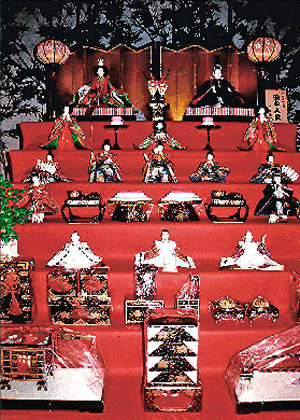 Each year, on March 3rd, Girl’s Day is celebrated throughout Japan. There are several Japanese names for this holiday: Hina-Matsuri, Hina-no-Sekku (both of which translate to Doll’s Festival), and the name from which the festival derives its roots, Momo-no-Sekku (Peach Blossom Festival). The celebration originated in ancient China as an event to mark one of the five seasonal periods (sekkus), and was embraced by Japan about 1300 years ago, during the Heian period. At that time, people made simple dolls of paper, which were created to gather illness, sins and bad fortune from the dolls’ makers. The undesirable dolls were then cast away in a stream or river to dispense of the bad fortune.
Each year, on March 3rd, Girl’s Day is celebrated throughout Japan. There are several Japanese names for this holiday: Hina-Matsuri, Hina-no-Sekku (both of which translate to Doll’s Festival), and the name from which the festival derives its roots, Momo-no-Sekku (Peach Blossom Festival). The celebration originated in ancient China as an event to mark one of the five seasonal periods (sekkus), and was embraced by Japan about 1300 years ago, during the Heian period. At that time, people made simple dolls of paper, which were created to gather illness, sins and bad fortune from the dolls’ makers. The undesirable dolls were then cast away in a stream or river to dispense of the bad fortune.
Today, Hina-Matsuri it is a celebration honoring girls, to encourage good health, prosperity and marriage, and to welcome the spring. Elaborate doll displays called hina ningyo make brief appearances in homes throughout Japan at this time. (The dolls are put away soon after Hina-Matsuri due to an old superstition that girls whose dolls are left out too long will be late to marry). These dolls represent the Japanese royal family during the Heian period, and are traditionally handed down from mother to daughter. Most sets contain fifteen hina dolls, all beautifully dressed in ornate miniature kimono and finery. They are set up on a tiered display with the emperor and empress on the top step, and their courtiers, arranged by rank, on the steps below them. On the lowest steps are miniature household items and furniture. The displays also feature peach blossoms and replicas of tiny traditional sweets.
As with all Japanese festivals, there are many symbolic foods for Hina-Matsuri. The tiny diamond-shaped multi-colored layered cakes that can be found on every hina ningyo display are called hishi mochi. The red (or pink) and white in the cakes are the traditional colors of celebration and longevity. (Many hishi mochi contain a bright green layer also.) Hina-arare (colorful rice puffs) also appear in these three colors during the festival, which some say represent white snow covering green grass, with pink peach blossoms on top. A colorful rice dish called chirashi-zushi and shellfish are also popular. And, to wash down all of these flavorful treats, a special type of sake containing no alcohol, called ama-sake, is made during this season.
If you haven’t seen a hina ningyo display, most large department stores have lovely examples. Take a few minutes this month to check one out before they go back into storage until next year!
